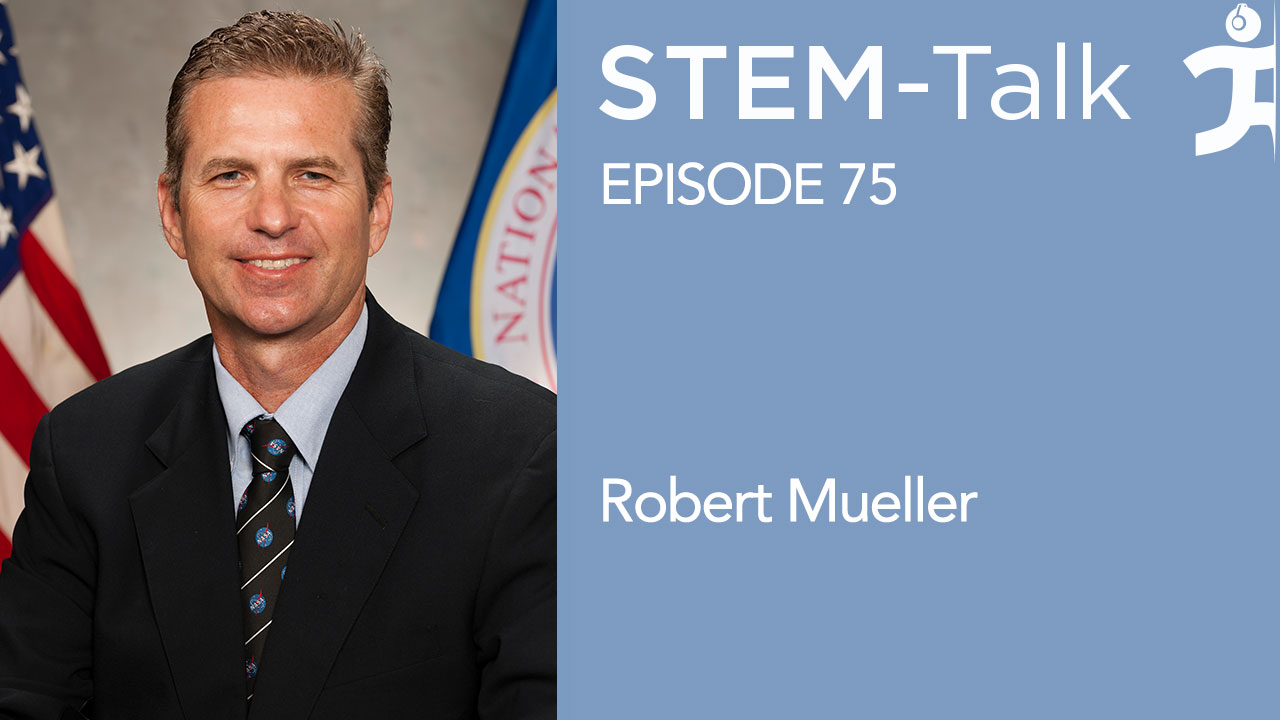STEM-Talk
Episode 75: Rob Mueller: Using the resources of space to build lunar outposts on the Moon and Mars
// Oct 23, 2018

Today’s guest today is Rob Mueller, one of NASA’s senior technologists who is leading an effort to establish a base station on the Moon, and eventually Mars, as well as other destinations in the solar system.
Rob is the senior technologist for the Advanced Projects Development at NASA Kennedy Space Center and a co-founder of Swamp Works, an innovation lab that has brought together NASA engineers, researchers and scientists to work on creating Spaceports across the solar system.
As most of our listeners know, NASA has been working toward an eventual mission to Mars. But before venturing to Mars, NASA first plans to build a lunar base on the Moon. In announcing the agency’s decision to return to the Moon, NASA Administrator Jim Bridenstine said that this time the agency isn’t interested in just leaving flags and footprints on the lunar surface. “This time when we go, we’re going to go to stay,” he said.
As part of this mission, Rob’s work is particularly focused on ways to excavate and mine the resources of space so that astronauts and eventually others will be able to live off the land in space. In today’s interview, Rob talks about his nearly 30-year career with NASA as well as the future of space exploration. Topics we cover include:
[00:12:40] In order to survive and thrive in space, we need to be able to build things in space. [00:14:51] Rob’s lab at NASA called Swamp Works. [00:18:44] Swamp Works’ goal of expanding civilization into the solar system. [00:20:33] The Regolith Advanced Surface Systems Operations Robot project. [00:24:59] How there are billions and billions of times the resources in outer space than here on Earth, and our potential to excavate these materials. [00:30:41] The Lunar Orbital Platform-Gateway. [00:35:29] NASA’s decision to return to the Moon before venturing to Mars. [00:37:33] How new technologies being developed for Spaceflight could eventually have applications on Earth as well. [00:40:29] How to survive and thrive on the Moon and Mars, we will need to be able to build landing pads, habitats and roads. [00:49:03] A partnership Swamp Works has with Astrobotic to develop a micro-rover. [00:51:11] How the regolith of the Moon, Mars and other planets as well as asteroids contain valuable resources. [00:54:12] The future of space exploration. [00:57:16] How Rob responds to people who question the cost and relevance of going to the Moon and beyond. [01:02:13] And if people are a little less likely to take Rob’s phone call given that there’s a Robert Mueller in Washington who’s conducting a Russian investigation.Show notes:
[00:03:26] Rob talks about growing up in Portugal and how Rob ended up with an international background as a kid because of his father’s work.
[00:04:00] Dawn asks Rob if it’s true that as a 12-year-old he was a pioneer of surfing in Portugal.{00:04:40] Rob talks about how his interest in advanced technology led him to the states and the University of Miami after graduating from high school.
[00:06:48} Rob describes how he graduated from Miami shortly after the Challenger accident and ended up applying for a job at NASA. [00:07:56} Ken points out that it was an O-ring on the Solid Rocket Boosters that failed to maintain a seal that led to the Challenger explosion. Ken asks Rob to talk about how he came to work on the Solid Rocket Boosters when NASA hired him in 1989. [00:10:09] Rob talks about he actually was more interested in robotics than space when he went to work at the Kennedy Space Center. [00:11:02] Dawn asks Rob about his decision to work on an MBA at the Florida Institute of Technology while he was working at NASA. [00:11:45] Dawn follows up with a question about how Rob ended up in the Netherlands studying for a master’s degree in internal space systems engineering. [00:12:40] Dawn points out that Rob has been at NASA for nearly 30 years and that he is often quoted as saying that if we are going to survive and thrive in space we need to be able to build things in space. She asks Rob to explain what he means by that. [00:14:51] Rob talks about his lab at NASA, called Swamp Works, and how the lab is trying to foster a more innovative environment at the space agency. [00:17:43] Dawn asks Rob how he came up with the name Swamp Works. [00:18:44] Rob mentions that a goal of Swamp Works is to expand civilization into the solar system. Dawns asks him to talk about what that means. [00:20:33] Ken points out the Rob is the lead technologist for the Regolith Advanced Surface Systems Operations Robot project, and asks Rob to talk about his work in this area. [00:24:59] Ken mentions that Carl Sagan was known to say that there are billions and billions of times the resources in outer space than here on Earth. Ken asks Rob to talk about the potential and possibilities that our ability to excavate these materials will provide. [00:27:56] Dawn talks about how we will need new technologies if we’re going to survive and thrive in space. She asks Rob about 3D printing, which is a good example of one of the technologies that could, with further development, completely change the game. [00:30:41]A few years ago, an asteroid mission was the official destination of NASA with respect to human spaceflight. Ken mentions that many of NASA’s current plans for the future of human spaceflight are focused on development of what is currently referred to as the Lunar Orbital Platform-Gateway. Ken asks Rob to describe the Gateway and the rationale for its construction. [00:35:29] Mars remains the long-term goal for human spaceflight. But from an engineering and budgetary perspective, Ken says it seems more logical to first return to the moon and that, indeed, the conversation within the agency has shifted back to the Moon. In announcing the agency’s decision to return to the Moon, NASA Administrator Jim Bridenstine said that this time the agency isn’t interested in just leaving flags and footprints on the lunar surface. “This time when we go,” he said, “we’re going to go to stay.” Ken asks Rob to talk about this promising development. [00:37:33] Dawn mentions that IHMC is working with NASA on designing an exercise machine for human Spaceflight beyond LEO (low-Earth orbit). NASA has known for a long time that astronauts on long-duration spaceflights lose muscle strength and mass as well as bone density because their bodies spend so much time in microgravity. Dawn says that one aspect of this project is that it could end up developing a whole new way of resistance training not only for space flight, but also for here on Earth. She asks Rob if the new technologies for space that he’s working on could also eventually have applications on Earth as well. [00:40:29] To survive and thrive on Mars, we will need to be able to build landing pads, habitats and roads. Dawn asks Rob to talk about the work that’s being done in this area. [00:42:42] In addition to the civil engineering requirements that will be needed to enable a sustainable presence on the Moon and eventually Mars, Ken says it makes sense to “live off the land” to the extent possible. In particular, insitupropellant production on the Moon, says Ken, seems intriguing. But given that it can take billions of dollars up front and years to deploy the infrastructure required to produce industrial levels of cryogenic propellants on the moon, Ken asks how can we ever get to the point where we have reusable systems using insituresources when it’s so much cheaper and faster just to use Earth-supplied expendable systems? [00:49:03] Dawn asks Rob about a partnership Swamp Works has with Astrobotic to develop a micro-rover. [00:51:11] Ken talks about how on Earth, regolith includes soil, which is a biologically active medium and a key component in plant growth as well as life on Earth. Although regolith also appears on the surfaces of the Moon, Mars and other planets as well as asteroids, their surfaces do not contain soil. But their surfaces do contain other valuable resources. Ken asks Rob to talk about this. [00:54:12] Dawn asks Rob to talk about the future of space exploration. [00:57:16] In the just-released movie “First Man,” which is about NASA’s mission to put a man on the moon, there are several scenes of politicians and demonstrators protesting the financial and human cost of going into space and traveling to the moon. She asks Rob to talk about how he responds to people who question the cost and relevance of going to the Moon and beyond. [01:02:13] Given the current Russian investigation that’s being conducted by Washington’s Robert Mueller, Dawn asks Rob if people are a little less likely to take his phone calls these days.
Links:
Video: NASA experiments with 3D-printing robots
The Verge: How NASA plans to use lunar dust to build structures on the Moon






